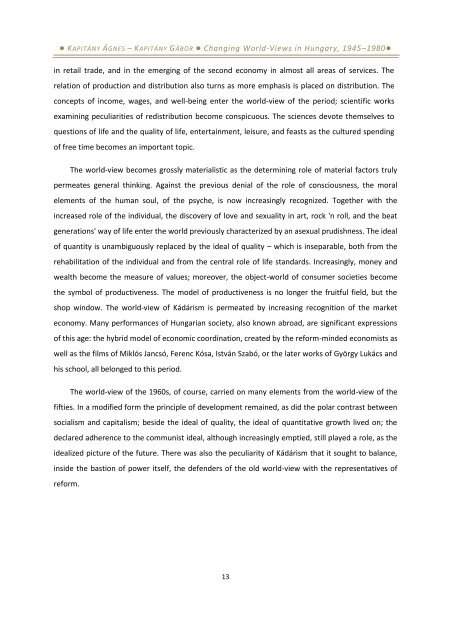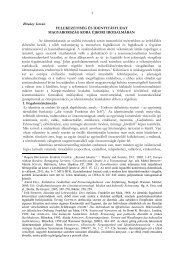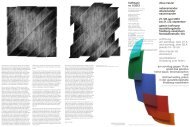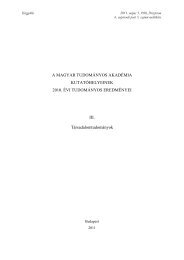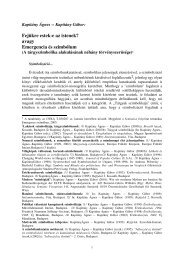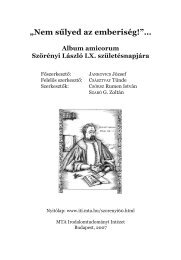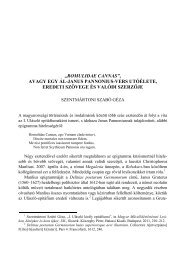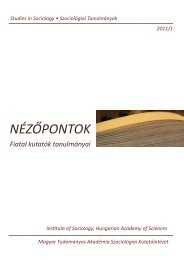symbolic elements of everyday culture - MTA Szociológiai ...
symbolic elements of everyday culture - MTA Szociológiai ...
symbolic elements of everyday culture - MTA Szociológiai ...
You also want an ePaper? Increase the reach of your titles
YUMPU automatically turns print PDFs into web optimized ePapers that Google loves.
● KAPITÁNY ÁGNES – KAPITÁNY GÁBOR ● Changing World-Views in Hungary, 1945–1980●<br />
in retail trade, and in the emerging <strong>of</strong> the second economy in almost all areas <strong>of</strong> services. The<br />
relation <strong>of</strong> production and distribution also turns as more emphasis is placed on distribution. The<br />
concepts <strong>of</strong> income, wages, and well-being enter the world-view <strong>of</strong> the period; scientific works<br />
examining peculiarities <strong>of</strong> redistribution become conspicuous. The sciences devote themselves to<br />
questions <strong>of</strong> life and the quality <strong>of</strong> life, entertainment, leisure, and feasts as the <strong>culture</strong>d spending<br />
<strong>of</strong> free time becomes an important topic.<br />
The world-view becomes grossly materialistic as the determining role <strong>of</strong> material factors truly<br />
permeates general thinking. Against the previous denial <strong>of</strong> the role <strong>of</strong> consciousness, the moral<br />
<strong>elements</strong> <strong>of</strong> the human soul, <strong>of</strong> the psyche, is now increasingly recognized. Together with the<br />
increased role <strong>of</strong> the individual, the discovery <strong>of</strong> love and sexuality in art, rock 'n roll, and the beat<br />
generations' way <strong>of</strong> life enter the world previously characterized by an asexual prudishness. The ideal<br />
<strong>of</strong> quantity is unambiguously replaced by the ideal <strong>of</strong> quality – which is inseparable, both from the<br />
rehabilitation <strong>of</strong> the individual and from the central role <strong>of</strong> life standards. Increasingly, money and<br />
wealth become the measure <strong>of</strong> values; moreover, the object-world <strong>of</strong> consumer societies become<br />
the symbol <strong>of</strong> productiveness. The model <strong>of</strong> productiveness is no longer the fruitful field, but the<br />
shop window. The world-view <strong>of</strong> Kádárism is permeated by increasing recognition <strong>of</strong> the market<br />
economy. Many performances <strong>of</strong> Hungarian society, also known abroad, are significant expressions<br />
<strong>of</strong> this age: the hybrid model <strong>of</strong> economic coordination, created by the reform-minded economists as<br />
well as the films <strong>of</strong> Miklós Jancsó, Ferenc Kósa, István Szabó, or the later works <strong>of</strong> György Lukács and<br />
his school, all belonged to this period.<br />
The world-view <strong>of</strong> the 1960s, <strong>of</strong> course, carried on many <strong>elements</strong> from the world-view <strong>of</strong> the<br />
fifties. In a modified form the principle <strong>of</strong> development remained, as did the polar contrast between<br />
socialism and capitalism; beside the ideal <strong>of</strong> quality, the ideal <strong>of</strong> quantitative growth lived on; the<br />
declared adherence to the communist ideal, although increasingly emptied, still played a role, as the<br />
idealized picture <strong>of</strong> the future. There was also the peculiarity <strong>of</strong> Kádárism that it sought to balance,<br />
inside the bastion <strong>of</strong> power itself, the defenders <strong>of</strong> the old world-view with the representatives <strong>of</strong><br />
reform.<br />
13


